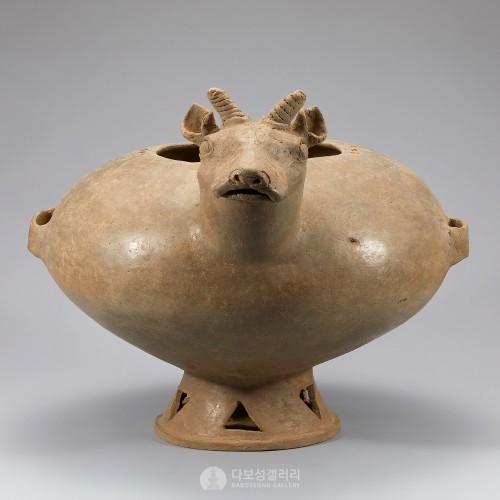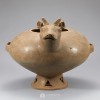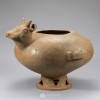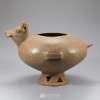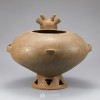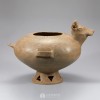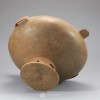본문
안으로 뚫린 입구의 항아리로 복부에는 양머리 형태의 출수구와 대칭되는 한 쌍의 귀가 달려있고, 나팔굽 위에는 삼각형 모양 구멍이 뚫려 있습니다.
전체에 회색 광택이 들며 풍만한 느낌을 주면서 앙증맞은 느낌까지 납니다. 화(盉)는 중국 고대에 술과 물을 섞던 그릇으로서 물을 섞어가며 술맛을 조절하는 기능을 했습니다.
중국에서 흙으로 그릇을 만드는 토기 문화는 신석기시대에 시작되어 도기 문화로 발전했습니다. 신석기시대의 중국 도기는 황하(黄河) 유역과 장강(長江) 유역·동남해안·북방 유역 등으로 광범위하게 분포합니다. 황하와 장강 중상류 지역은 채도로 유명하고, 하류 지역은 정교한 백도기(白陶器)와 흑도기(黑陶器)로 유명하며, 동남해안 지역은 경도기(硬陶器)로 대표되고, 북방 지역은 특색 있는 조형도기로 유명합니다. 신석기 도기는 제작 방법에 따라 수제(手製)·모제(模製)·완륜(慢輪)·쾌륜(快輪)으로 나뉘며, 문양으로는 압인(壓印)·박인(拍印)·각화(刻畵)·채색(彩繪)·누공(鏤孔)으로 나뉩니다. 제작 가마로는 횡혈요·수혈요가 있습니다. 이처럼 다양한 신석기시대의 다양한 도기문화는 오늘날 도자기의 모태가 되었습니다.
罐开口通往内部,腹中部置羊头形的直流和对称的双系,下称圈足,呈喇叭形。圈足上饰三角形镂孔。造型独特,饱满丰盈,甚是可爱。
盉是中国古代的盛酒器,是古人调和酒、水的器具,用水来调和酒味的浓淡,与现在的酒壶相似。
中国新石器时代的陶器分布相当广泛,其主要分布区域有黄河流域、长江流域、东南沿海及北方地区等。黄河、长江中上游地区以彩陶闻名,下游地区以工艺精湛的白陶和黑陶著称;东南沿海地区以印纹硬陶为代表;北方地区则以富有民族特色的造型陶器称奇。陶器是原始时期极为重要的创造。新石器时代生活在中国境内的原始先民们发明了制陶技术,开始使用陶器。各地区的陶器都有其独特之处,但相互之间又存在着内在的联系。新石器时代的陶器,从陶质区分,有红陶、灰陶、黑陶、白陶和彩陶;从工艺上区分,有手制、模制、慢轮、快轮;从纹样上区分,有压印、拍印、刻画、彩绘、镂孔;从陶窑区分,有横穴窑与竖穴窑。正是这些风格迥异,各不相同的类别,创造了新石器时代绚丽多姿的陶器文化。
A hollow pouring vessel with a sheep-head spout and a pair of lug handles on the stomach. Equilateral triangular holes are on the splayed pedestal.
The surface is burnished into a sheen grey, and the whole figure is ample and adorable. Hé is an ancient Chinese pouring vessel for watering down the taste of drinks by mixing water.
Chinse pottery began in the Neolithic period and developed into earthenware. Neolithic Chinese earthenware is widely distributed along the Yellow River, the Yangtze River, the southeast coast, and the northern basin. The upper-middle areas of the Yellow River and Yangtze River are known for painted pottery, the downstream area is known for elaborate white pottery and black pottery, the southeast coastal area is represented by hard pottery, and the northern region is famous for its distinctive shaped pottery. It is also divided into the hand-made, mold-made, slow wheel, and the fast wheel by production method. The patterns are divided into stamped, printed, engraved, painted, and perforated. Kiln types include horizontal kilns and vertical kilns. As such, various pottery cultures of the Neolithic Age became the beginning of pottery today.
